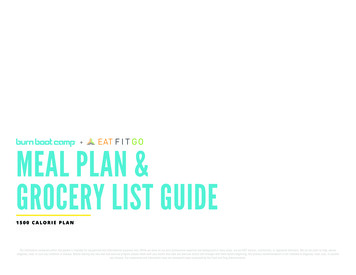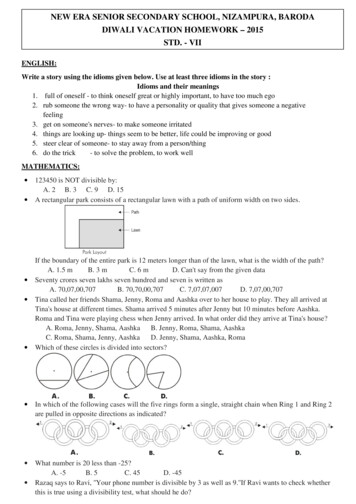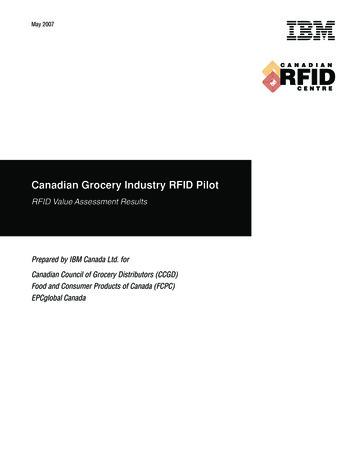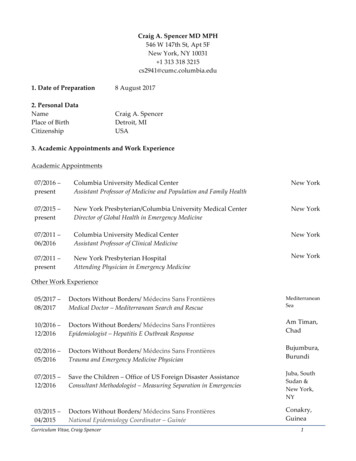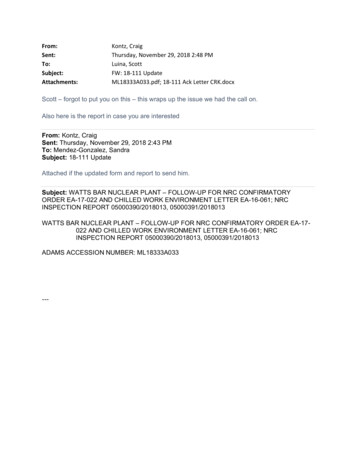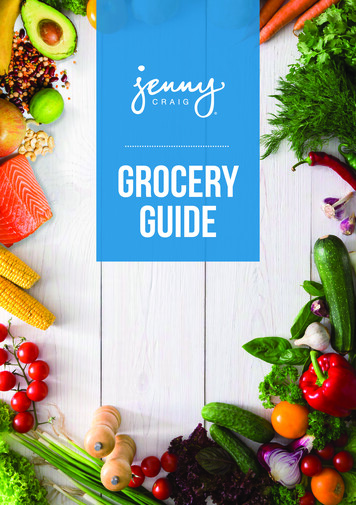
Transcription
GROCERYGUIDE1
Our top tipsfor successGroceryGuideAt Jenny Craig your weekly menuplan is designed by dietitians toprovide the right balance of nutritionfor weight loss and good health.Your menu is a personal healthyeating plan, combining nutritiousand satisfying, portion controlledJenny Craig foods with yourown choices of fresh fruit andvegetables, grains, milk, meat, meatalternatives and fat serves.Don’t forget to double your portionfor ‘free’! Fill your plate with ‘FreeFoods’ to help keep you full andsatisfied between meals. See page14 for details.As you move towards your weightloss goals, you will learn how toplan and prepare meals on yourown. This is an important part of theJenny Craig program and ensuresyou’re learning healthy habits thatwill stick with you for life.2Eating well - not dieting!Developing a healthy relationshipwith food means understandinghow you can enjoy delicious foodand stay in control. There are no‘good’ or ‘bad’ foods, it’s aboutlearning how all foods can beenjoyed, in moderation, as partof a healthy, balanced diet. Thisguide will help you to personaliseyour menu to include your favouritefoods as you achieve your weightloss goals and good health.Refer to your menu or discusswith your Consultant the numberof grocery serves you need forthe week.For more resources to help you throughoutyour weight loss journey be sure to go tothe Resource centre:AUS: www.jennycraig.com.au/resourcesNZ: www.jennycraig.co.nz/resources1. Be organisedPrepare for the week by checking the shopping list onyour menu.2. HydrateKeep up your water intake, it may be fluid, not food youneed.3. Eat enoughRemember to eat everything on your menu plan. Yourkilojoule level is worked out to be the right amount of foodthat you need to lose weight and still get all the nutritionyour body needs. Skipping meals or eating less food isn’tgoing to help speed up the weight loss process, in factsometimes it can have the opposite effect and may impactyour metabolism.4. Eat mindfullyListen to your hunger cues. Savour every meal, chewslowly and enjoy every mouthful.5. Fill up for freeFeeling peckish? Wanting more food? Remember, nonstarchy vegetables are Free Foods and can help keep yousatisfied by adding them to your meals and enjoying themas snacks in between. See page 14 for a complete list ofFree Foods.6. Plate it upPresent your Jenny Craig meal and grocery serves on aplate and take the time to sit down and focus on enjoyingyour meal without distractions.7. Track itThose who monitor what they do are more successful withlifestyle change. Keep a journal so you can monitor yourprogress – it can also influence and change the choicesyou make!3
fruitvegetablesApproximately 250-350kJ and 15g carbohydrate per serve. Some fruits are‘Free Foods’ in limited quantities. See the Limited Free Foods list on page 15.FRESH FRUIT1 SERVEApple, Banana (small), Dragon fruit, Feijoa, Grapefruit,Nashi pear, Nectarine, Orange, Paw paw, Peach, Pear, Quince1 small tomedium pieceCustard apple, Jackfruit, Mango, Persimmon, Pomegranate½ pieceApricots, Figs (fresh), Guavas, Kiwifruit, Mandarins, Plums,Starfruit, Tangelos, Tangerines2Dates (fresh)3Cumquats, Lychees, Passionfruit, Rambutans6Grapes½ cupBerries (blackberry, blueberry, cranberry, loganberry, mulberry,raspberry, strawberry), Cherries, Cut fruit (melon/cantaloupe,pineapple, mixed fruit salad)1 cupCANNED FRUIT (in natural juice, drained)1 SERVEE.g. Apple, Apricot, Fruit salad, Grapefruit, Mandarin, Mango,Peach, Pear, Pineapple, Plum½ cupDRIED FRUIT1 SERVEApple4 ringsApricots6Figs2Goji berries2 tbspMango5 stripsNectarine, Peach2 halvesPaw paw¼ cup, 20gPear½, 20gPrunes, Dates3Cranberries, Currants, Raisins, Sultanas1 tbspFRUIT JUICES (unsweetened) (Maximum of 1 serve per day)1 SERVEFruit juice½ cupCoconut water1 cup4Approximately 0-100kJ per serve. Non-starchy vegetables are also ‘Free Foods’. Theminimum recommended amount of vegetables is 5 serves per day. Use the serve sizeguide below.NON-STARCHY VEGETABLES AND SALAD1 serveArtichoke, Asparagus, Bamboo shoots, Beans (string), Beansprouts (alfalfa sprouts, mung bean sprouts, soy bean sprouts),Beetroot, Bok choy, Broccoli, Broccolini, Chinese broccoli,Brussels sprouts, Cabbage, Capsicum, Carrot, Cauliflower,Celeriac, Celery, Cucumber, Daikon radish, Eggplant, Fennel,Kale, Kohlrabi, Leek, Mushroom, Okra, Onion, Radish, Rhubarb(stewed, no added sugar), Salad greens ( eg. baby spinach,lettuce, radicchio, rocket), Sauerkraut, Silverbeet, Snow peas,Spinach, Squash (button), Sugarsnap peas, Swede, Tamarillo,Tomato, Turnip, Zucchini1 cup raw vegetablesor salad½ cup cookedvegetables½ cup cannedvegetables, no addedsaltStarchy Vegetables1 serveStarchy vegetables are higher in kilojoules and carbohydratesand are classed as ‘Grains’.See ‘Grains’ liston page 6 & 7EATACROSSTHERAINBOWEnjoy fruits and vegetables with a variety ofcolours to get a great range of nutrients.5
grainsApproximately 350-450kJ, 20g carbohydrate, 3g protein and 3g fat per serve.Choose wholegrain/wholemeal options where possibleBreads/Crackers1 serveMiscellaneous1 serveBagelBread (wholegrain, multigrain, rye, sourdough, wholemeal,white, raisin/fruit, Turkish)Breadcrumbs½Chestnuts, roasted40g, 5 nuts1 sandwich slice (35-40g)Flour (wholemeal, white)2 tbsp, 20gPopcorn, plain, air popped3 cupsCrispbread3 (3 x 10g)Probiotic drink65ml ½ GrainCrumpet1 roundRice paper4 sheetsDinner roll, Sandwich thin1 (30-40g)Pumpernickel2 small slices (2 x 25g)Choose less often1 serveHoney, Jam, Maple syrup1 tbspRice/Corn cakes2 thick style, 4 thin styleChocolate drinking powder (Milo )1 tbspRice or Water crackers10Sorbet½ cupBread roll (large), English muffin½Sugar1 tbspPita pocket1 small, or ½ largeSalada crackers6 small squaresTortilla, thin15cmLebanese bread1Higher Fat Grains 1 Grain 1 Fat1 serve1Cereals1 serveBarley, Buckwheat, Bulgur, Farroh, Freekeh, Millet, Oats½ cup cooked,¼ cup uncookedHommus, reduced fatSoup (canned, ready to eat, salt reduced): cream-based,lentil, tomato, vegetable & meatCouscous, Polenta, Quinoa, Rice, Semolina, Sorghum, Teff1CHOOSE LESS OFTEN 1 GRAIN 1 FAT1 serveMuesli¼ cupBread (roti, naan)35g (½ piece)Pasta, Noodles (egg, rice, soba)½ cup cookedChocolate6 squares 1 Grain 2 FatWholegrain flake cereal² ³ cupChocolate hazelnut spread1 tbspWhole wheat breakfast biscuit (e.g. WeetbixTM, Vita BritsTM)2 biscuitsCrackers, regular fat, small, round7Legumes – counted as a grain serve*1 serveIce-cream (low fat), Frozen yoghurt (low fat)½ cupMuesli bar1, 35gPancake, prepared from mix1, 50gPikelet, ready to eat2, 25gScone, plain½Sweet muffin/cupcake, not iced, medium½, 30g2 ½ tbsp/³/³ cup cookedBeans (e.g. baked beans, black beans, borlotti beans, broad½ cup cooked or cannedbeans, cannellini beans, edamame beans, kidney beans,(salt reduced)soy beans), Chickpeas, Lentils, Split peas*Legumes: due to their high protein and carbohydrate content these can be counted as a Meat or Grain serve,however, the amount varies depending on the food group chosen.Approximately 530-630kJ, 20g carbohydrate, 3g protein and 3g fat per serve./³ cup, 4 tbsp1 cup, 250gStarchy Vegetables (cooked)1 serveHot cross bun1 small, 40gCorn, Peas, Potato, Sweet potato/Kumara, Taro½ cupPlain cake (sponge)5cm squareJerusalem artichoke, Parsnip, Pumpkin, Water chestnuts1 cupPlain sweet tea biscuits, uncoated, unfilled2-3 small6TMTM- Trademark of Societe Des Produits Nestle SA- Trademark of Australasian Conference Association Limited7
meat & meat alternativesApproximately 200-300kJ, 7-10g protein and 3g fat per serve.Approximately 380-480kJ, 7-10g protein and 3g fat per serve.Lean Meats and Meat Alternatives1 serveHigher Fat Meats 1 Meat 1 Fat1 serveBeef (lean), Goat, Kangaroo, Lamb, Pork (lean), Poultry/Chicken (skinless), Rabbit, VealCalamari, cooked30g (cooked)Beef (brisket, sirloin, ribs), cooked30gMince (chicken, beef, pork, lamb), cooked30gCheese: yellow varieties (reduced fat), feta (reduced fat)20g, 2 tbsp grated, 1 sliceCheese: Cottage, low fat¼ cupCheese: Ricotta, reduced fat¼ cupChicken in spring water, canned85g, 1 small canEgg whites4Fish (tuna, salmon, sardines, white fish), cooked45g60gDeli meat (lean ham, turkey, roast beef, roast chicken slices) 45g, 2 slicesCheese: yellow varieties, regular fat, e.g. cheddar, parmesan 20g, 2 tbsp grated, 1 sliceCheese: Ricotta, regular fat¼ cupCheese: Feta, Bocconcini, Mozzarella (regular fat)35gCheese: Goats cheese40gCheese: Haloumi (salt reduced)40gEgg, large1Fish, crumbed, pan-fried45gPork (forequarter, chops, spareribs), cooked30gTofu (firm/hard)80gTuna, Salmon, Sardines in oil, drained45g, ½ small canAnchovies55g, approx. 12CHOOSE LESS OFTEN 1 MEAT 1 FAT1 serveBacon, fat trimmed,cooked30gOffal (brains, kidneys), cooked40gMussels, cooked50g, 5 smallOysters, raw6Quorn (fillets, meatballs, mince), cooked50gShellfish (crabs, lobster, prawns, scallops), cooked60gSmoked salmon30g, 3 slicesTempeh, Tofu (silken/soft)100gBeef pattie/hamburger, grilled1, 50gTuna, Salmon, Sardines in spring water, drained45g, ½ small canChicken loaf60g1/³ cup cooked or cannedHot dog, Frankfurt, cooked1 small(salt reduced)Poultry, with skin/fried30gSalami30gLegumes*: Beans (e.g. baked beans, black beans, borlottibeans, broad beans, cannellini beans, edamame beans,kidney beans, soy beans), Chickpeas, Lentils, Split peas*Legumes: due to their high protein and carbohydrate content these can be counted as a Meat or Grain serve,however, the amount varies depending on the food group chosen.Sausage, grilledSoy/vegetarian sausage, grilled81 thin sausage,70g 1 Meat 2 Fat1 sausage, 50g9
milk/DAIRYApproximately 350-450kJ, 15g carbohydrate, 7-10g protein and 3g fat per serve.Approximately 530-630kJ, 15g carbohydrate, 7-10g protein and 3g fat per serveMilk/DAIRY1 serveHigher Fat Milk/DAIRY 1 Milk/DAIRY 1 Fat1 serveNon-fat, Skim or 1% Fat milk (including lactose free milk)1 cup, 250mlFat free/Low fat yoghurt - Natural, Greek, plain or flavouredFull cream milk: 4% fatCheese: yellow varieties, regular fat, e.g. cheddar,parmesanCheese: Cottage, regular fat1 cup, 250ml2Cheese: Feta, regular fat40gGoat milk1 cup, 250mlSoy milk, regular, added calcium1 cup, 250mlPowdered milk, full cream3 tbspCustard, regular fat½ cupFull fat yoghurt200g 1 Milk 2 FatEvaporated milk, regular½ cup 1 Milk 2 FatCheese: Ricotta, regular fat½ cup 1 Milk 2 FatButtermilk, low fat/³ cup, 200g container1 cupCheese: yellow varieties, reduced fat40g, 4 tbsp grated, 2 slicesCheese: Cottage, low fat½ cupCheese: Feta, reduced fat40gCheese: Goats40gCheese: Ricotta, reduced fat½ cupEvaporated milk, skim½ cupPowdered milk, skim3 tbspSoy milk, low fat, added calcium1 cup, 250mlCustard, low fat½ cupMilk/DAIRY Alternatives1 serve40g, 4 tbsp grated, 2 slices½ cupThe following milk alternatives tend to be lower in protein, with some being higher in carbohydrate and lower incalcium compared to skim dairy milk varieties. Therefore you’ll need to add the extra grocery serves* specifiedbelow, and choose varieties with added calcium where possible.Almond, Coconut, Oat, Rice milk (UHT)1 cup, 250ml 1 meat serve*Note: adding extra grocery serves will add extra kilojoules to your menu plan. Some of these alternativesmay also be naturally higher in kilojoules when compared to skim milk products.YOGHURTNeed Help with which yoghurt to choose?Turn to page 16 for some guidanceon choosing yoghurt.1011
fatsApproximately 180kJ and 5g fat per serve.Monounsaturated and Polyunsaturated Fats(Choose more often)1 serve/8,1 tbspAvocado1DukkahPlant spread/margarine1 tbsp1 tspMayonnaise, Tartare sauce, Aioli1 tspNuts:Almond, cashew, hazelnut6Brazil, walnut halves2Macadamia, pecan halves3Peanut, pine nut, pistachio10Nut meal (e.g. almond meal, hazelnut meal)2 tspLSA (linseed, sunflower seed and almond meal)Nut spreads, no added salt, unsweetened(peanut butter, almond, cashew, tahini)Oil (avocado, canola, corn, flaxseed, grapeseed, macadamia,olive, peanut, safflower, sesame, soybean, sunflower)Oil-based salad dressing, regular fat2 tspOlives8Olive tapenade1 tbsp1 tsp1 tspSaturated Fats (Choose less often)1 serveButter1 tspCream, regular fat, thickened2 tspSpreadable cream cheese, regular fat1 tbsp, 20gSpreadable cream cheese, light1½ tbsp, 30gSpreadable cream cheese, extra light2 tbsp, 40gCreamy salad dressing, regular fat2 tspCreamy salad dressing, reduced fat1 tbspCoconut, desiccated/shredded/dried)3 tspCoconut, fresh15g fleshCoconut milk, canned, regular fat1 tbspCoconut milk, canned, low fat/light2 tbspCoconut oil1 tspSour cream, regular fat2 tspSour cream, reduced fat/light1 tbsp3 tspPesto2 tspSeeds (chia, linseed/flaxseed, pepita/pumpkin, poppy, sesame,2 tspsunflower)10 pieces 1 Fat Sundried tomato (in oil)½ GrainWHY EAT FAT?Dietary fats are needed to move somevitamins around the body, createhormones and for energy.1213
free foodslimited free foodsApproximately 0-100kJ per serve.Free Foods are low in kilojoules and can add extra volume, flavour and varietyto your menu.You can also put your own spin on your Jenny Craig meals to suit your tastepreferences by adding Free Foods. Enjoy Free Foods in moderation.Enjoy up to 3 Limited Free Food serves per day.Free FoodsFruitBeveragesSugar Substitutes/Artificial SweetenersNon-Starchy VegetablesFlavour EnhancersNOTE: choose reduced saltsauces where availableCoffee, Tea,Soda/Sparkling/Mineral Water (plain or flavoured with noadded sugar).If you choose to decrease your caffeine intake, do sogradually. Milk and sugar added to beverages are notincluded in the Free Food list.Natural/artificial sweeteners can be used in place ofsugar.Artichoke, Asparagus, Bamboo shoots, Beans (string),Bean sprouts (alfalfa sprouts, mung bean sprouts, soybean sprouts), Beetroot, Bok choy, Broccoli, Broccolini,Chinese broccoli, Brussels sprouts, Cabbage, Capsicum,Carrot, Cauliflower, Celeriac, Celery, Cucumber, Daikonradish, Eggplant, Fennel, Kale, Kimchi, Kohlrabi, Leek,Mushroom, Okra, Onion, Radish, Rhubarb (stewed,no added sugar), Salad greens (e.g. lettuce, radicchio,rocket), Sauerkraut, Silverbeet, Snow peas, Spinach,Squash (button), Sugarsnap peas, Swede, Tamarillo,Tomato, Turnip, ZucchiniBroth/Stock, Capers, Chilli sauce, Yeast extract(Vegemite ), Fish sauce, Garlic, Ginger, Gherkins/pickles (unsweetened), Herbs - fresh, dried, paste (e.g.basil, coriander, dill, mint, oregano, parsley, rosemary,thyme), Horseradish, Lemon juice, Lime juice, Mustard,Pickled onions, Seaweed, Sriracha sauce, Spices (e.g.chilli, cinnamon, cumin, curry powder, nutmeg, paprika,turmeric), Soy sauce, Tabasco sauce, Tomato paste,Vinegar, Wasabi, Worcestershire sauceDRINK WATER14If you’re not properly hydrated you canfeel tired and even hungry.Aim to drink plenty of water every day! - Trademark of Mondelez Australia (Foods) LtdLimited Free Foods1 serveDiet soft drink, Diet tonic water, Diet cordial (made up with water)250ml (1 cup)Vegetable juice (low salt)125ml (½ cup)Berries, Grapefruit, Melon (all types), Paw paw½ cupLychees, Passionfruit, Rambutans2Cherries8 mediumOtherCacao beans3Custard powder, cocoa powderPsyllium husks, unprocessed bran2 tsp1 serve,¼ pack approx1 tbspLSA1 tspGravy (ready-made or powder made up with water)¼ cupRice paper1 sheetKonjac noodles, Kelp noodles250gDiet jellySauces/Condiments30gGherkins/pickles (sweetened)BBQ Sauce, Chutney, Jam or fruit spread (low sugar), Kecap manis, 2 tspHoisin sauce, Oyster sauce, Sweet chilli sauce, Teriyaki sauce,Vegetable relishFat free salad dressing, Fat free mayonnaise, Miso paste,1 tbspShrimp paste, Tomato sauce, Tomato ketchup2 tbspSalsa, Taco sauceSearching for Free Food ideas? Refer to theResource Centre for lots of recipe inspiration:AUS: www.jennycraig.com.au/resourcesNZ: www.jennycraig.co.nz/resources15
YoghurtHow to make good choicesNatural, Greek, plain or flavoured?Why is yoghurt good for me?Yoghurt is a great source of protein, carbohydrates, vitamins and minerals, as wellas probiotics (good bacteria) for a healthy digestive system. Yoghurt is digestedand absorbed slowly in our bodies, helping to keep us fuller for longer. Yoghurt isalso rich in calcium, which helps to keep our bones strong.How do I know which Yoghurts to choose?The best way to make good choices when selecting yoghurts is to choose thosethat fit as close as possible to the kilojoules in a Jenny Craig Milk/Dairy serve. Thisis between 350kJ and 450kJ per serve.Generally, this equates to to 200g (or 2/3 cup). However, the portion may be moreor less, depending on the individual yoghurt.Aim for a yoghurt with 350kJ – 450kJ per serveExample: Fat Free Natural Yoghurt3350kJ –450kJNUTRITION INFORMATIONServing size: 200gAverage Quantityper servingEnergy16440kJ104CalAverage Quantityper 100g220kJ52CalProtein10.6g5.3gFat, total- saturated0.2g0.2g0.1g0.1gCarbohydrate- sugars14.8g11.0g7.4g5.5gDietary Fibre 0.2g 0.1gSodium180mg90mgCalcium340mg170mgNatural, Greek, plain or flavoured yoghurts can all be good choices, the importantfactor to consider is how many kilojoules they contain per serve. Greek yoghurtstend to be higher in protein, which may help you feel fuller for longer.What about sugar?All yoghurts contain natural sugars, so there will always be a small amount of naturalsugar that will appear under ‘sugars’ in the Nutrition Information Panel. It’s ok if youwish to choose a fruit yoghurt (which may have a small amount of added sugar),provided it does not exceed the kilojoules in a Jenny Craig Milk/Dairy serve.What if I don’t like yoghurt?Yoghurt has so many health benefits, but if yoghurt really isn’t for you, you canchoose from a selection of other calcium-rich foods. These are found in yourGrocery Guide under Milk/Dairy serves.Get creative with yoghurt!SweetSavouryCrumble your Jenny CraigBreakfast Bar into your yoghurtAdd your favourite spice mix to Greekyoghurt and serve as a creamy dip withveggie sticksServe yoghurt with your cerealinstead of milkUse natural or Greek yoghurt in place ofmayonnaiseAdd your fruit serve to plain yoghurteg. top your yoghurt with a dicedkiwifruit, fresh berries or a sliced bananaand cinnamonTurn your Greek or natural yoghurt intoa tzatziki or raita using cucumber, garlic,lemon juice and fresh herbs, and servewith one of Jenny Craig’s internationaldishesServe yoghurt as a parfait, layeredwith diet jelly and berries for anafter dinner treatSubstitute sour cream for Greek yoghurtand serve with one of Jenny Craig’sMexican meals.Make fruit and yoghurt popsicles byblending fruit and yoghurt together in ablender and freezing in a popsicle mouldSwap creamy salad dressings for ahomemade dressing by mixing togetherplain yoghurt, lemon juice and crackedblack pepper17
VISUAL CUESTrain your eyes to calculate portion sizes by using the visual cues listed below181 tsp 1 die1 tbsp 2 AA batteries¼ cup (4 tbsp) 1 large egg/³ cup make up compact½ cup 1 tennis ball1 cup 1 medium orange45g sliced meat 2 DVDs90g meat, poultryand fish deck of cards40g reduced fat cheese 2 slices cheese2WHEN DINING OUTUSE THE “HEALTHY PLATE”MODEL AS A GUIDE1Meat, poultry,fish & meatalternativesVegetables& saladGrains/³ cup 200g tub of yoghurt19
STRategies for successHere are a few techniques to help you in makingdecisions about food and physical activity to set youon the path towards a successful journey.P.R.P. TECHNIQUES.T.O.P. TECHNIQUEKeep your response or explanation short. There isno need to share your personal goals unless youwant to.S.T.O.P.Unplanned, unconscious and emotional eating can betriggered by many feelings. You may be hungry, angry,anxious, lonely, sad, tired, bored, or even happy or excited!Be aware of your emotions and practice the S.T.O.Ptechnique to avoid them creating an urge to eat or drink.STOP!Hold up! Pause! Before eating or drinking anything, say to yourself “I havechoices here.”THINKAm I actually hungry or thirsty? Or am I just having this because it is there infront of me? Am I craving this because of an emotion I am experiencing?Social situations can be challenging, especiallywhen there is an array of food and drinks on offer.Declining an offer and saying ‘no’ takes practice,but it is important to know that it is okay to say‘no’ to an offering of food or drink.It’s not selfishto make yourhealth a priority.Practice saying ‘no’ politely with the P.R.P. techniquebelow:POLITE RESPONSE:“Thanks for offering, your cake does look delicious!”REASON FOR REFUSING:“Dinner was perfect and I couldn’t imagine eating another bite.”POLITE RESPONSE:“I’ll have to try it next time.”Then say to yourself “What am I going to do?”OVERVIEWWhat impact would this have on my weight and my goals?Will it take me closer or further away?Say to yourself “Will I feel ok if I eat it?”POLITE RESPONSE:“Did you make these yourself? Well done!”REASON FOR REFUSING:“I’ve just had a large lunch meal, but thank you.”PICKMake a conscious choice to support your goals. Feel empowered by yourawareness of your feelings.POLITE RESPONSE:“I’ll let everyone else enjoy them.”Ideas for Healthy Alternatives to EatingTake a quick napCall/text a friendWrite in a journalListen to music20Call your ConsultantGo for a quick walkEnjoy a bath/showerGo online to the Jenny Craig blog*There is more detailed information about ‘Managing Food Offers & Options’ in theonline Social Eater strategy card.21
STRategies for successNOTESFOUR STEP SOLUTIONA lapse is a single event – maybe you didn’t follow your plan, you missed a walkor let negative self-talk drive your day. Rather than ‘throw in the towel’, use it as anopportunity to learn and get back on track toward your goals.Lapses happen and are completely normal, but it ishow you respond to them that matters.1FORGIVE YOURSELF:The slip will not affect your weight loss if you get back on track now. Your lapsewas a single event, a moment in your journey from which to learn and review why ithappened, this way you can make plans for a different result in the future.2ANALYSE THE SITUATION AND YOUR TYPICAL RESPONSE:Where were you? Who were you with? What was going on? “I was with friends at a party and everyone was enjoying the finger food.I wanted to as well.”What did you say to yourself?“I’ve been ‘good’ all week, a few won’t hurt.”How did you feel? “I deserve a treat for how ‘good’ I’ve been.”What did you do?“Ate 5 pieces of finger food and had 3 glasses of wine.”3 PLAN YOUR STRATEGY FOR NEXT TIME: Whenfaced with the situation again, what will you:Say to yourself? “I am in control of my choices. My goals are more important to me than thisfood & drink.”Do differently?“I will bring a veggie plate with salsa and drink sparkling water after one glassof wine.”Encourage yourself to feel?“Proud that I overcame the challenge and focused on my goals.”4 SUMMARISE AND REHEARSE YOUR PLAN:Discuss your plan with your Consultant and rehearse with them – the more you say itand rehearse it, the more it will become second nature for the next time you need it.2223
24JC0118
Honey, Jam, Maple syrup 1 tbsp Chocolate drinking powder (Milo ) 1 tbsp Sorbet ½ cup . Non-fat, Skim or 1% Fat milk (including lactose free milk) 1 cup, 250ml Fat free/Low fat yoghurt - Natural, Greek, plain or flavoured 2/³ cup, 200g container Buttermilk, low fat 1 cup
